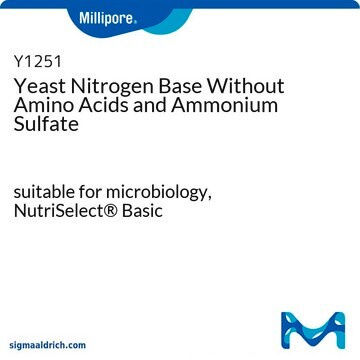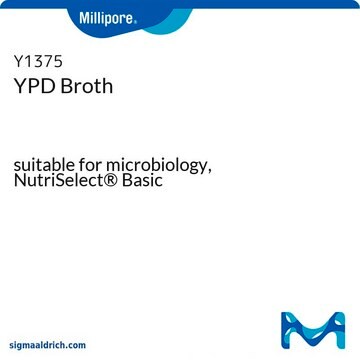Y1501
Yeast Synthetic Drop-out Medium Supplements
without uracil
Synonim(y):
Synthetic drop-out medium for yeast
About This Item
Polecane produkty
Szukasz podobnych produktów? Odwiedź Przewodnik dotyczący porównywania produktów
Zastosowanie
Komponenty
Amino acids: All standard amino acids are present at a concentration of 76 mg/L except for leucine, which is present at 380 mg/L.
Other nutrients: Adenine (18 mg/L), inositol (76 mg/L), p-aminobenzoic acid (8 mg/L)
Inne uwagi
Ilość
Kod klasy składowania
13 - Non Combustible Solids
Klasa zagrożenia wodnego (WGK)
WGK 1
Temperatura zapłonu (°F)
Not applicable
Temperatura zapłonu (°C)
Not applicable
Środki ochrony indywidualnej
Eyeshields, Gloves, type N95 (US)
Certyfikaty analizy (CoA)
Poszukaj Certyfikaty analizy (CoA), wpisując numer partii/serii produktów. Numery serii i partii można znaleźć na etykiecie produktu po słowach „seria” lub „partia”.
Masz już ten produkt?
Dokumenty związane z niedawno zakupionymi produktami zostały zamieszczone w Bibliotece dokumentów.
Klienci oglądali również te produkty
Produkty
Transformation introduces exogenous DNA into cells, a fundamental genetic modification process demonstrated in Streptococcus pneumoniae.
Genetic engineering enables large-scale expression and isolation of recombinant proteins for research purposes.
Inżynieria genetyczna umożliwia ekspresję na dużą skalę i izolację rekombinowanych białek do celów badawczych.
Protokoły
Yeasts are considered model systems for eukaryotic studies as they exhibit fast growth and have dispersed cells.
Magnetic-plasmonic nanoparticles: Synthesis and application of Ag/FeCo/Ag nanobeads for cellular organelle imaging and isolation.
Nanocząstki magnetyczno-plazmoniczne: Synteza i zastosowanie nanoperełek Ag/FeCo/Ag do obrazowania i izolacji organelli komórkowych.
Techniki hodowli drożdży: Systemy modelowe do badań eukariotycznych z płynnymi pożywkami lub wzrostem na płytkach agarowych.
Nasz zespół naukowców ma doświadczenie we wszystkich obszarach badań, w tym w naukach przyrodniczych, materiałoznawstwie, syntezie chemicznej, chromatografii, analityce i wielu innych dziedzinach.
Skontaktuj się z zespołem ds. pomocy technicznej












